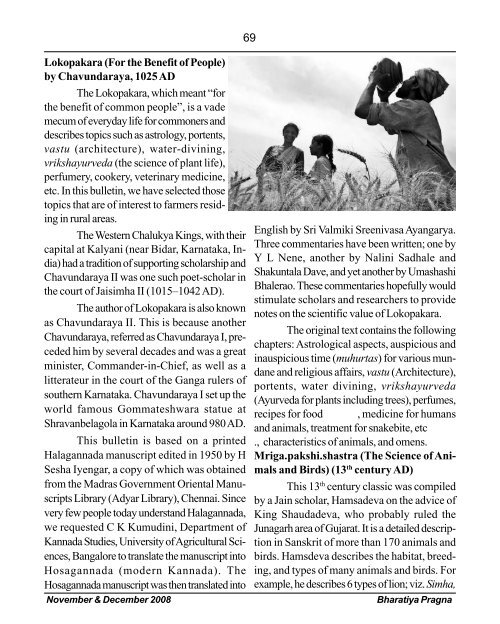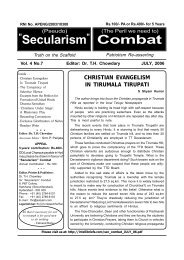Bharatiya Pragna - Dr. Th Chowdary
Bharatiya Pragna - Dr. Th Chowdary
Bharatiya Pragna - Dr. Th Chowdary
Create successful ePaper yourself
Turn your PDF publications into a flip-book with our unique Google optimized e-Paper software.
Lokopakara (For the Benefit of People)<br />
by Chavundaraya, 1025 AD<br />
<strong>Th</strong>e Lokopakara, which meant “for<br />
the benefit of common people”, is a vade<br />
mecum of everyday life for commoners and<br />
describes topics such as astrology, portents,<br />
vastu (architecture), water-divining,<br />
vrikshayurveda (the science of plant life),<br />
perfumery, cookery, veterinary medicine,<br />
etc. In this bulletin, we have selected those<br />
topics that are of interest to farmers residing<br />
in rural areas.<br />
<strong>Th</strong>e Western Chalukya Kings, with their<br />
capital at Kalyani (near Bidar, Karnataka, India)<br />
had a tradition of supporting scholarship and<br />
Chavundaraya II was one such poet-scholar in<br />
the court of Jaisimha II (1015–1042 AD).<br />
<strong>Th</strong>e author of Lokopakara is also known<br />
as Chavundaraya II. <strong>Th</strong>is is because another<br />
Chavundaraya, referred as Chavundaraya I, preceded<br />
him by several decades and was a great<br />
minister, Commander-in-Chief, as well as a<br />
litterateur in the court of the Ganga rulers of<br />
southern Karnataka. Chavundaraya I set up the<br />
world famous Gommateshwara statue at<br />
Shravanbelagola in Karnataka around 980 AD.<br />
<strong>Th</strong>is bulletin is based on a printed<br />
Halagannada manuscript edited in 1950 by H<br />
Sesha Iyengar, a copy of which was obtained<br />
from the Madras Government Oriental Manuscripts<br />
Library (Adyar Library), Chennai. Since<br />
very few people today understand Halagannada,<br />
we requested C K Kumudini, Department of<br />
Kannada Studies, University of Agricultural Sciences,<br />
Bangalore to translate the manuscript into<br />
Hosagannada (modern Kannada). <strong>Th</strong>e<br />
Hosagannada manuscript was then translated into<br />
69<br />
English by Sri Valmiki Sreenivasa Ayangarya.<br />
<strong>Th</strong>ree commentaries have been written; one by<br />
Y L Nene, another by Nalini Sadhale and<br />
Shakuntala Dave, and yet another by Umashashi<br />
Bhalerao. <strong>Th</strong>ese commentaries hopefully would<br />
stimulate scholars and researchers to provide<br />
notes on the scientific value of Lokopakara.<br />
<strong>Th</strong>e original text contains the following<br />
chapters: Astrological aspects, auspicious and<br />
inauspicious time (muhurtas) for various mundane<br />
and religious affairs, vastu (Architecture),<br />
portents, water divining, vrikshayurveda<br />
(Ayurveda for plants including trees), perfumes,<br />
recipes for food , medicine for humans<br />
and animals, treatment for snakebite, etc<br />
., characteristics of animals, and omens.<br />
Mriga.pakshi.shastra (<strong>Th</strong>e Science of Animals<br />
and Birds) (13 th century AD)<br />
<strong>Th</strong>is 13 th century classic was compiled<br />
by a Jain scholar, Hamsadeva on the advice of<br />
King Shaudadeva, who probably ruled the<br />
Junagarh area of Gujarat. It is a detailed description<br />
in Sanskrit of more than 170 animals and<br />
birds. Hamsdeva describes the habitat, breeding,<br />
and types of many animals and birds. For<br />
example, he describes 6 types of lion; viz. Simha,<br />
November & December 2008 <strong>Bharatiya</strong> <strong>Pragna</strong>



